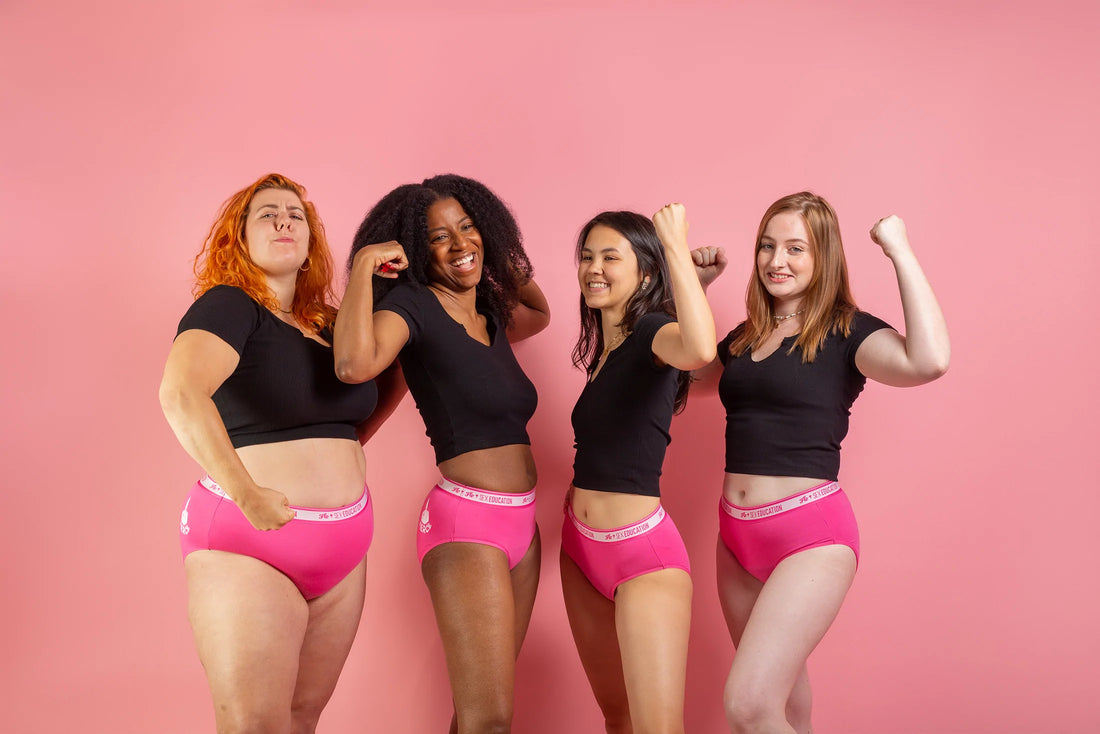Alright besties, for Plastic Free July let's address the elephant in the room: plastic in period products.
Last year the European Union introduced their Single Use Plastics Directive (SUPD). It basically means if a brand is selling in the EU and has any plastic in their products, they need to include a “Plastic in Product” label on their packaging.
SO FLO, DO YOU NEED THE LABEL?
In short, yes, we do! Allow us to climb onto our biodegradable soapbox and tell you why. Plastic is a dirty word, but did you know there are actually different kinds of plastic? The small amount of plastic we use in FLO products are plant-based plastics, otherwise known as "bioplastics". These bioplastics actually breakdown, whereas "normal" - oil or petroleum-based - plastics do not.
WHAT IS THE DIFFERENCE BETWEEN A "BIOPLASTIC" AND "NORMAL" PLASTIC?
Compostable bioplastics are biopolymers that break down into non-toxic organic matter after use and cause no harm to the environment.
Whereas oil and petroleum-based plastics can take hundreds and hundreds of years to break down. These are the "bad" plastics that cause permanent damage to our planet.
BUT FLO, WHY DO YOU NEED THE LABEL IF YOU ONLY USE BIOPLASTICS?!
For menstrual products, the SUPD doesn’t recognise the difference between petroleum-based plastic products and plant-based plastic products. It requires all types of plastic to be labelled, making it difficult for us to communicate our biodegradable bioplastic alternative.
But remember, when you think of FLO, you can be assured that any bioplastic we're using: 1) breaks down into organic matter and 2) is made from plants, not petroleum! 3) our products never have and never will contain microplastics!
Let's take a look at a FLO Eco-applicator Tampon as an example of where these bioplastics show up (*).

Now lets take a look at our best-selling Bamboo Period Pads!
Because waterproof back sheets are needed to keep you dry and free from leaks, all pads and liners have one. We and all other organic and natural brands use a sustainable plant-based bioplastic material called PLA which is compostable and made from sugar and cornstarch. This material is TUV Austria certified home compostable and is what we use for our pad and liner wrappers too - which is why our wrappers can be disposed of in your bin or in the compost. (*)
WHAT OTHER MATERIALS MAKE UP FLO PRODUCTS?
FLO pads and liners are made of 100% organic bamboo, making them super absorbent and comfy. The wrappers look like plastic but are actually home compostable, made from a plant-based bioplastic wrapper that's cleverly created from cornstarch and sugarcane. This means FLO pads and liners are the most sustainable single-use products on the market.
Our tampons are made from 100% organic cotton - not just a cotton core like other brands! The Eco-applicators are made from a sugarcane bioplastic and before you ask, no, you can't eat it because it's sugarcane. The applicator is however 95% plant-based and fully recyclable. To top it off, our tampon wrappers are made from Naturflex, a cellulose paper that looks and feels like plastic, but actually is fully plant-based.
SO FLO, DO YOU SUPPORT THE SINGLE USE PLASTIC DIRECTIVE?
With lots of greenwashing out there, SUPD ensures you know if plastic that permanently damages the planet is being used in your products.
At FLO, we want to always communicate with our community in a way that’s completely transparent. The SUPD logo on our packaging is just another way for us to do exactly that!
WILL FLO EVER USE "NORMAL" PLASTICS?
Nope! We promise our sustainable period products will never ever contain petroleum or oil-based plastics. If you’re using FLO you’re choosing an eco-friendly alternative. We only use bioplastics when required for the best efficacy and experience, like our silkyyy-smooth tampon applicators. For any coochies that have been caught on a cardboard applicator in the past, don't worry bestie, we got you.
Our wonderful Operations Executive, Emily Peters (who is currently studying Space Science and Technology & also has a BSc degree in Marine Biology & Ecology AND has a PGCE in Secondary Science!😲🤓) made this amazing video on just how a bioplastic is made...enjoy!


